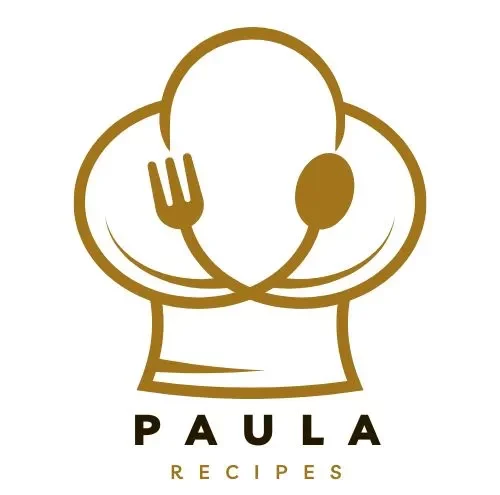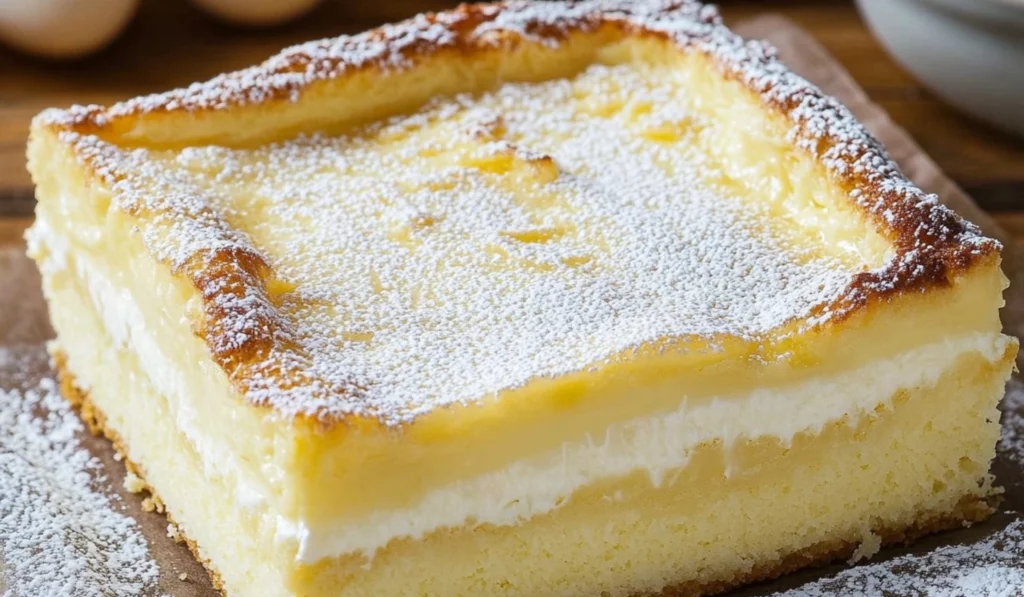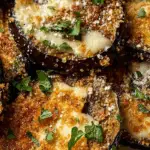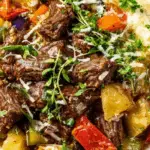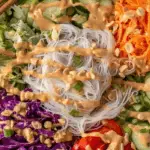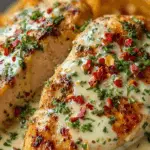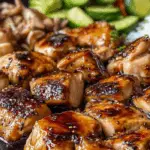There’s a certain allure to a cake that transforms as it bakes, creating distinct layers of texture and flavor. The Vanilla Magic Custard Cake is a testament to this, offering a delightful surprise with every bite. It’s a dessert that’s as fascinating to prepare as it is to savor. I recall my first encounter with this cake. I was intrigued by the concept of a “magic” cake and decided to give it a try. The simplicity of the ingredients and the straightforward instructions made it seem approachable, even for a beginner baker like myself. The result was nothing short of magical: a cake with a dense, buttery base, a creamy custard center, and a light, airy top. It was a revelation, and I was hooked. This recipe is an ideal starting point for beginner bakers. It requires no complicated techniques, uses readily available ingredients, and delivers a stunning dessert that’s sure to impress. The magic of the cake lies in the simple science of baking, where the different densities of the batter create the distinct layers. It’s a great way to build confidence in the kitchen and create a dessert that tastes like it came from a professional bakery.
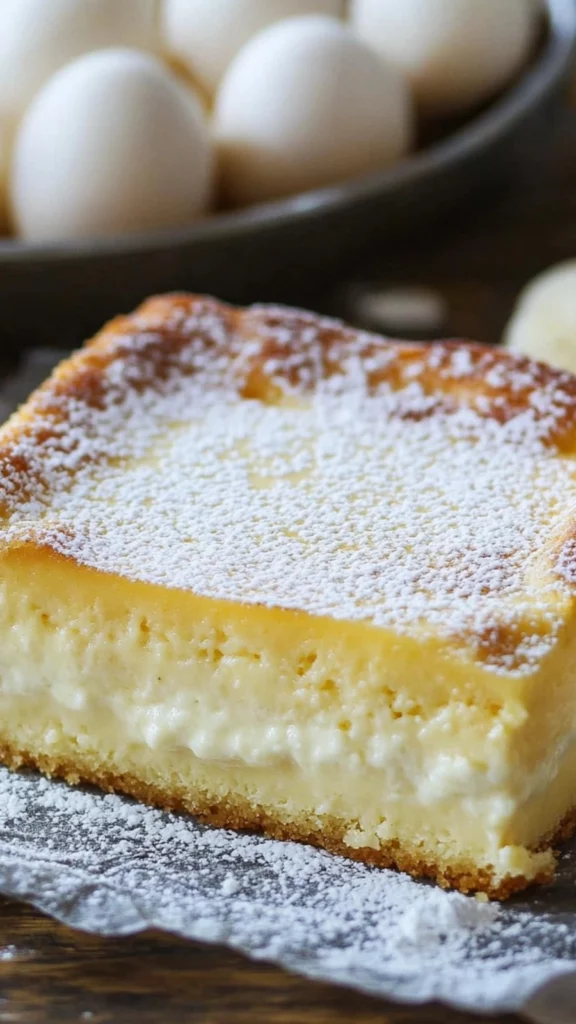
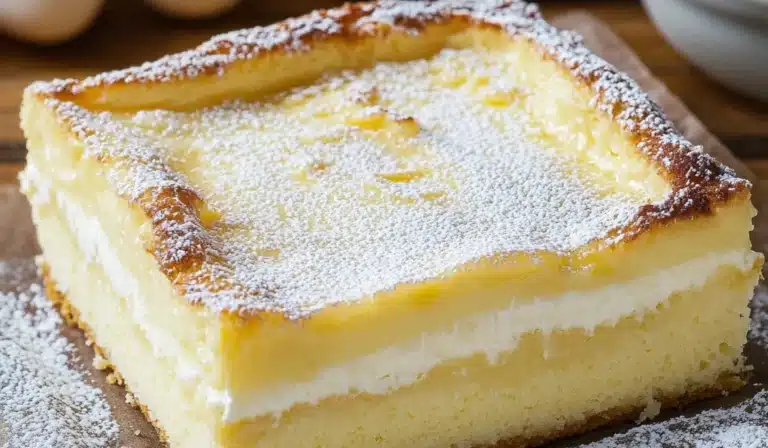
Vanilla Magic Custard Cake: A Beginner’s Delight
Experience a melt-in-your-mouth Vanilla Magic Custard Cake with three distinct layers: a dense base, creamy custard center, and light, airy top.
- Total Time: 1 hour
- Yield: 10 slices 1x
Ingredients
- 1/2 cup unsalted butter, melted and slightly cooled
- 2 cups milk, lukewarm
- 1 and 1/4 cups (150 g) powdered sugar
- 4 eggs, separated
- 1 Tablespoon water
- 1 cup (115g) flour
- 2 teaspoons vanilla extract
- powdered sugar for dusting
Instructions
- Preheat the Oven and Prepare the Pan: Preheat the oven to 325°F (160°C). Lightly grease an 8×8 inch baking dish and set it aside. Greasing the pan prevents the cake from sticking and ensures easy removal. You can also line the pan with parchment paper for added insurance.
- Whip the Egg Whites: Separate the eggs, placing the whites in a clean, dry bowl. Use an electric mixer to whip the egg whites until stiff peaks form. Stiff peaks mean the whites hold their shape when the beaters are lifted. Set the whipped egg whites aside. Whipping the egg whites creates the light, airy top layer of the cake. Ensure that the bowl and beaters are completely clean and dry, as any trace of grease can prevent the egg whites from whipping properly.
- Beat the Egg Yolks and Sugar: In a separate bowl, beat the egg yolks and powdered sugar until pale yellow. Beating the yolks and sugar creates a smooth, creamy base for the batter. Continue beating until the mixture is light and fluffy.
- Mix in Butter and Water: Mix in the melted butter and water for about 2 minutes until evenly combined. This step ensures that the butter and sugar are fully incorporated, creating a smooth and emulsified batter.
- Mix in Flour: Mix in the flour until evenly incorporated. Mixing the flour gently prevents over-mixing, which can result in a tough cake. Use a rubber spatula or a whisk to gently fold in the flour.
- Add Milk and Vanilla: Slowly beat in the lukewarm milk and vanilla extract until well combined. Adding the milk slowly prevents the batter from becoming lumpy. Continue beating until the mixture is smooth and homogenous.
- Fold in Egg Whites: Gently fold in the whipped egg whites, one-third at a time, repeating until all the egg whites are incorporated. Folding gently prevents the egg whites from deflating, which is crucial for creating the light, airy top layer. Use a rubber spatula to gently fold the egg whites into the batter.
- Pour and Bake: Pour the batter into the prepared baking dish and bake for 40-60 minutes, or until the cake is barely jiggly in the center. Baking time may vary depending on your oven and pan. Start checking the cake after 40 minutes. If the top browns too quickly, cover it loosely with aluminum foil.
- Cool and Dust: Cool the cake completely before dusting with powdered sugar. Even when cooled, the cake will be slightly jiggly due to the custard layer in the center. Cooling the cake completely allows the layers to set properly and prevents the powdered sugar from melting.
Notes
- Whip egg whites to stiff peaks for airy top.
- Fold egg whites gently to maintain volume.
- Cool cake completely for best texture.
- Check for doneness with a gentle jiggle.
- Prep Time: 15 minutes
- Cook Time: 45 minutes
- Category: Dessert
- Method: Bake
- Cuisine: American
Ingredients and Preparation: The Foundation of Culinary Magic
This recipe relies on a carefully selected combination of simple ingredients that, when combined and baked, create a truly magical dessert. Here’s a detailed breakdown with added tips and tricks to ensure baking success:
- Unsalted Butter: 1/2 cup, melted and slightly cooled. Melted butter adds richness, moisture, and a subtle buttery flavor to the cake. Use unsalted butter to control the salt content and ensure the cake isn’t overly salty. Allow the melted butter to cool slightly before adding it to the batter to prevent it from cooking the eggs.
- Lukewarm Milk: 2 cups. Lukewarm milk helps the ingredients combine smoothly and creates a creamy, custard-like texture in the center layer of the cake. Avoid using cold milk, as it can solidify the melted butter and create lumps in the batter.
- Powdered Sugar: 1 and 1/4 cups (150g). Powdered sugar dissolves easily and creates a smooth, sweet batter. It also contributes to the delicate texture of the cake.
- Eggs: 4, separated. Separating the eggs is crucial for creating the three distinct layers. The egg yolks add richness, color, and a custard-like texture, while the egg whites create the light, airy top layer.
- Water: 1 tablespoon. A small amount of water helps to emulsify the butter and sugar, creating a smooth and cohesive batter.
- All-Purpose Flour: 1 cup (115g). All-purpose flour provides the structural integrity of the cake, giving it its shape and texture. Use unbleached all-purpose flour for best results.
- Vanilla Extract: 2 teaspoons. Vanilla extract enhances the flavor of the cake and adds a warm, comforting aroma. Use pure vanilla extract for the best flavor.
- Powdered Sugar for Dusting: For garnish. A light dusting of powdered sugar adds a touch of sweetness and elegance to the finished cake.
Alternative Ingredient Suggestions (Expanded and Detailed):
- Butter: You can use salted butter, but omit or reduce the amount of salt in the recipe. You can also use a dairy-free butter substitute for a vegan option.
- Milk: You can use whole milk, 2% milk, or even almond milk. However, the texture and flavor may vary slightly. Coconut milk will add a distinct coconut flavor.
- Powdered Sugar: You can use granulated sugar, but the texture of the cake may be slightly different. The cake might have a slightly grainy texture.
- Eggs: Use fresh, large eggs for best results. If you have smaller eggs add an extra egg.
- Flour: You can use gluten-free all-purpose flour for a gluten-free version. Ensure that the gluten free flour blend is a 1:1 substitute.
- Vanilla Extract: You can use other extracts, such as almond extract or lemon extract, for a different flavor profile. You can also use vanilla bean paste for a more intense vanilla flavor.
Step-by-Step Instructions: Creating Your Vanilla Magic Custard Cake Masterpiece
- Preheat the Oven and Prepare the Pan: Preheat the oven to 325°F (160°C). Lightly grease an 8×8 inch baking dish and set it aside. Greasing the pan prevents the cake from sticking and ensures easy removal. You can also line the pan with parchment paper for added insurance.
- Whip the Egg Whites: Separate the eggs, placing the whites in a clean, dry bowl. Use an electric mixer to whip the egg whites until stiff peaks form. Stiff peaks mean the whites hold their shape when the beaters are lifted. Set the whipped egg whites aside. Whipping the egg whites creates the light, airy top layer of the cake. Ensure that the bowl and beaters are completely clean and dry, as any trace of grease can prevent the egg whites from whipping properly.
- Beat the Egg Yolks and Sugar: In a separate bowl, beat the egg yolks and powdered sugar until pale yellow. Beating the yolks and sugar creates a smooth, creamy base for the batter. Continue beating until the mixture is light and fluffy.
- Mix in Butter and Water: Mix in the melted butter and water for about 2 minutes until evenly combined. This step ensures that the butter and sugar are fully incorporated, creating a smooth and emulsified batter.
- Mix in Flour: Mix in the flour until evenly incorporated. Mixing the flour gently prevents over-mixing, which can result in a tough cake. Use a rubber spatula or a whisk to gently fold in the flour.
- Add Milk and Vanilla: Slowly beat in the lukewarm milk and vanilla extract until well combined. Adding the milk slowly prevents the batter from becoming lumpy. Continue beating until the mixture is smooth and homogenous.
- Fold in Egg Whites: Gently fold in the whipped egg whites, one-third at a time, repeating until all the egg whites are incorporated. Folding gently prevents the egg whites from deflating, which is crucial for creating the light, airy top layer. Use a rubber spatula to gently fold the egg whites into the batter.
- Pour and Bake: Pour the batter into the prepared baking dish and bake for 40-60 minutes, or until the cake is barely jiggly in the center. Baking time may vary depending on your oven and pan. Start checking the cake after 40 minutes. If the top browns too quickly, cover it loosely with aluminum foil.
- Cool and Dust: Cool the cake completely before dusting with powdered sugar. Even when cooled, the cake will be slightly jiggly due to the custard layer in the center. Cooling the cake completely allows the layers to set properly and prevents the powdered sugar from melting.
Beginner Tips and Notes: Mastering the Art of Vanilla Magic Custard Cake
- Troubleshooting: Cake is dense: If your cake is dense, you may have over-mixed the batter or not whipped the egg whites enough. Make sure to fold the egg whites gently and avoid over-mixing.
- Troubleshooting: Cake is too jiggly: If your cake is too jiggly after the recommended baking time, continue baking for a few more minutes until it’s barely jiggly.
- Troubleshooting: Top browns too quickly: If the top of your cake browns too quickly, cover it loosely with aluminum foil halfway through baking.
- Egg White Whipping: Use a clean, dry bowl and beaters to whip the egg whites. Any trace of grease or yolk can prevent them from whipping properly.
- Folding Technique: Use a rubber spatula to gently fold in the egg whites. Avoid stirring or beating, as this can deflate them.
- Oven Temperature: Ensure your oven is preheated to the correct temperature. An oven thermometer can help you check the temperature.
- Pan Size: Use an 8×8 inch baking dish for this recipe. Using a different size pan may affect the baking time and the texture of the cake.
- Cooling Time: Allow the cake to cool completely before dusting with powdered sugar. This allows the layers to set properly and prevents the powdered sugar from melting.
- Egg Separation: Separate the eggs while they are cold, it is easier to do.
- Don’t over mix: Over mixing creates a tough cake. Mix until just combined.
- Use quality ingredients: This cake is made with simple ingredients, so quality ingredients are important.
Serving Suggestions: Completing Your Vanilla Magic Custard Cake Experience
This Vanilla Magic Custard Cake is delicious on its own, but you can enhance the experience with a few thoughtful additions:
- Fresh Fruit: Serve the cake with fresh berries, such as strawberries, raspberries, or blueberries, for a refreshing contrast.
- Whipped Cream: Top the cake with a dollop of whipped cream for a light and airy addition.
- Fruit Sauce: Drizzle the cake with a fruit sauce, such as raspberry sauce or strawberry sauce, for added flavor and sweetness.
- Ice Cream: Serve the cake with a scoop of vanilla ice cream or your favorite flavor for a decadent dessert.
Storage Tips for Leftovers:
To maintain the moisture and texture of your Vanilla Magic Custard Cake, proper storage is essential. Here’s a comprehensive guide:
- Refrigerator Storage: Store leftover cake in an airtight container in the refrigerator for up to 3 days. The cake is best enjoyed within the first 2 days, as the texture may change slightly over time.
- Preventing Drying: To prevent the cake from drying out, ensure the container is tightly sealed. You can also place a piece of parchment paper or plastic wrap directly on the cut surface of the cake to create an extra barrier against air.
- Individual Slices: If you have individual slices, wrap each slice tightly in plastic wrap or aluminum foil before placing them in an airtight container.
- Reheating: If you prefer your cake slightly warm, you can gently reheat individual slices in the microwave for a few seconds. Be careful not to overheat the cake, as this can make it dry.
- Freezing: While not recommended for optimal texture, you can freeze the cake. Wrap individual slices tightly in plastic wrap, then place them in a freezer-safe bag or container. Thaw overnight in the refrigerator.
Tips for Maintaining Freshness:
- Avoid storing the cake in a humid environment, as this can make it soggy.
- If you notice any signs of mold or spoilage, discard the cake immediately.
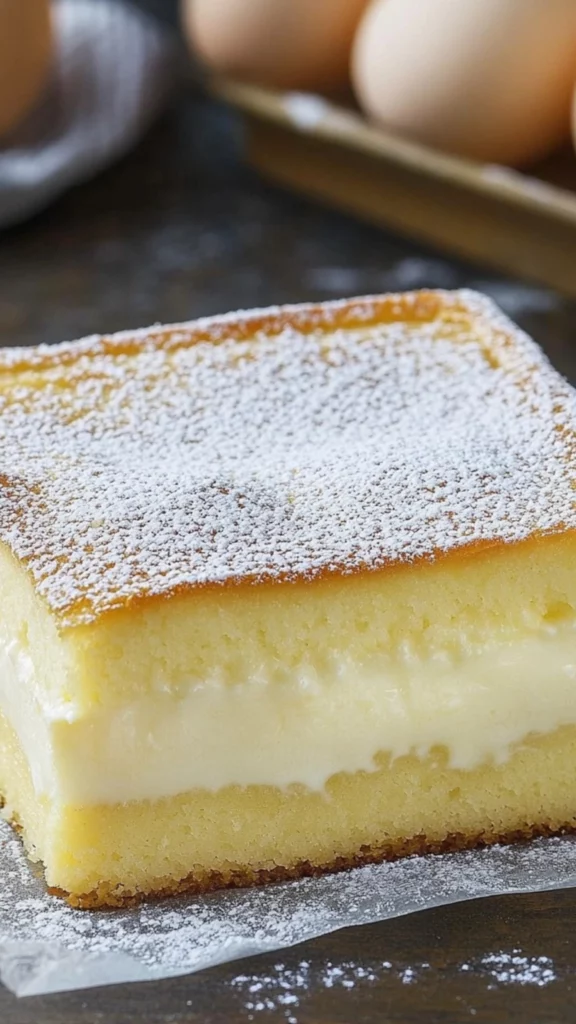
Conclusion: Share Your Culinary Creations!
This Vanilla Magic Custard Cake is a truly delightful and surprisingly easy dessert to create. I wholeheartedly encourage you to try this recipe and share your baking experiences in the comments below! I’d love to hear about your variations, tips, and tricks. Did you add any extra flavors, use different extracts, or get creative with the garnishes? Your feedback is invaluable and inspires other bakers. Let us know how your cake turned out and what serving suggestions you enjoyed most. Share your photos and tag me on social media so I can see your Vanilla Magic Custard Cake masterpieces! Use #VanillaMagicCake and #EasyBakingRecipes so I can find your creations. I also enjoy seeing your baking adventures on Instagram stories, so feel free to tag me and show off your creations. Happy baking, and I can’t wait to see what you create!
